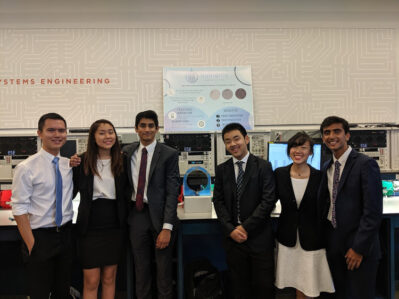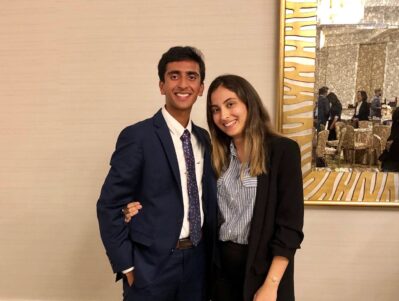
M&TSI was the most rewarding summer program I have ever attended. Taking place on UPenn’s beautiful campus in the heart of Philadelphia from July 7th to 27th, the program served to integrate the principles of engineering with the practice of management to create a holistic overview of the Jerome Fisher Program in Management and Technology. I attended M&TSI this past summer to gain an understanding of whether or not I wanted to pursue an education in engineering. Most of my high school years, I envisioned pursuing a career in finance and investment banking by majoring in economics or some related discipline; however, I realized that taking this path would not allow me to fully explore the technical, mathematical, and statistical aspects of such a career. I always enjoyed engineering through the lens of robotics, but I needed to experience an engineering education first hand to assess whether it was right for me. I was fortunate in discovering through M&TSI that a blend of engineering and business can quench my thirst for an interdisciplinary and engaging education.
What prompted you to apply to be an M&TSI attendee?
I wanted to be an M&TSI attendee for two reasons. Firstly, I wanted to know whether the Jerome Fisher Program in Management and Technology was right for me, and even more broadly, whether the University of Pennsylvania was a good environment to further my education. I approached this question in two ways: I looked at what UPenn and M&T could offer me, and what I could offer them in return. I was not surprised to find that UPenn and specifically M&T faculty and students included people from diverse backgrounds who could stimulate insightful thought experiments that would allow for growth as interdisciplinary learners as entrepreneurs and engineers. Secondly, I wanted to gain a more in-depth understanding of what an engineering education entailed and how it could be combined with management to promote innovation. In looking for the answer to this question, I found that UPenn is the breeding ground for innovative companies that infiltrate industries ranging from healthcare to agriculture.
What was a typical day like?
A typical day usually involved a 9:00 A.M. lecture with Professor Jeffrey Babin, which would then usually be followed with a guest speaker who would integrate the lecture with their real-life experiences with starting and sustaining a company. Lectures involved beginning with a 15-minute quiz on the case study reading from the previous night and then continued to build off principles that were elucidated from the case study. Following morning lecture with Professor Babin, students were given a lunch break after which they were lectured in engineering by Professor Sid Deliwala. This lecture often included a discussion of the essence of engineering and the different types of engineering that are offered at Penn. After the lecture, students conducted a lab using their Arduino, learning the basics of circuits and Arduino programming. Finally, the day culminated with teams grouping to work on their prototyping and business model for their product.
How did your team come up with your product? What was it?
Coming up with a product was probably one of the more difficult parts of M&TSI. Our group went through an extensive ideation phase, which involved the creation of almost 250 ideas that we had to widdle down to one eventually. We assessed different factors such as feasibility and our ability to market and scale our product at a high level. In the end, we decided to create “Lightgate,” which was a window that allowed the user to control its opacity, thereby increasing or decreasing how much natural sunlight enters the room. By utilizing principles of physics, we implemented rotating polarizing lenses to prototype this window. We also created an accompanying app that took the user input for how much light the user wanted entering the room. This was a challenging project and took intensive CAD and hardware design skills, but at the end of the day, we were able to create a working prototype of a window that actually could change its opacity.
What was your favorite part of the program?
My favorite part of the program was spending three weeks with students that challenged me in ways that I had never been challenged before. I was required to always think and have insightful conversations about case studies or engineering topics that I had never been able to have. In turn, these conversations created long-lasting friendships with a diverse group of individuals and unforgettable memories.
What was challenging?
I think the most challenging part of the program was getting kids who had never worked together before collaborate in a team environment. I found that at the beginning, my team faced a constant power struggle where everyone was trying to get their opinions heard, but no one was listening to each other. To excel in a high-pressure environment like M&TSI, a team where everyone is fighting needs to select someone to take point; otherwise, you will never actually get anything accomplished. It took a while for everyone to take down their echo chambers and collaborate in a meaningful way, but once everyone realized their unique role in the team, tasks were much easier to get accomplished.

What was your biggest takeaway from M&TSI?
My biggest takeaway from M&TSI was that to grow as a leader, entrepreneur, and problem solver I need to accept and manipulate my talents for the benefit of the team. Working in groups is an indispensable skill, and in school we aren’t forced to do it enough or to the level that we need to. M&TSI taught me how to lead and contribute to a team without fomenting hostility or frustration that can create stagnation in workflow.
How did M&TSI help shape your future academic/career goals?
M&TSI reaffirmed my interest in pursuing management and business while pushing me towards a career in engineering. I think after M&TSI, I could say with confidence that I want engineering to play a role in my pursuit of higher education, and integrating the principles of management and engineering would develop the worldview I desire to have: one that can travel beyond traditional borders of problem-solving.
Anything else you’d like to add?
In my opinion, one of the best presentations of M&TSI was Professor Rakesh Vohra’s presentation on systems engineering. In this lecture, he described the strategies for designing an optimal centralized college application system. His lecture was particularly interesting because the discipline involved designing a process that was dependent on minute details. I realized that writing out the algorithms for complex code was the type of work I wanted to focus on. Without Professor Vohra’s lecture and M&TSI, I probably would have never discovered systems engineering, but I am grateful to have experienced his talk, which focused me on exactly what type of engineering I wanted to pursue.


